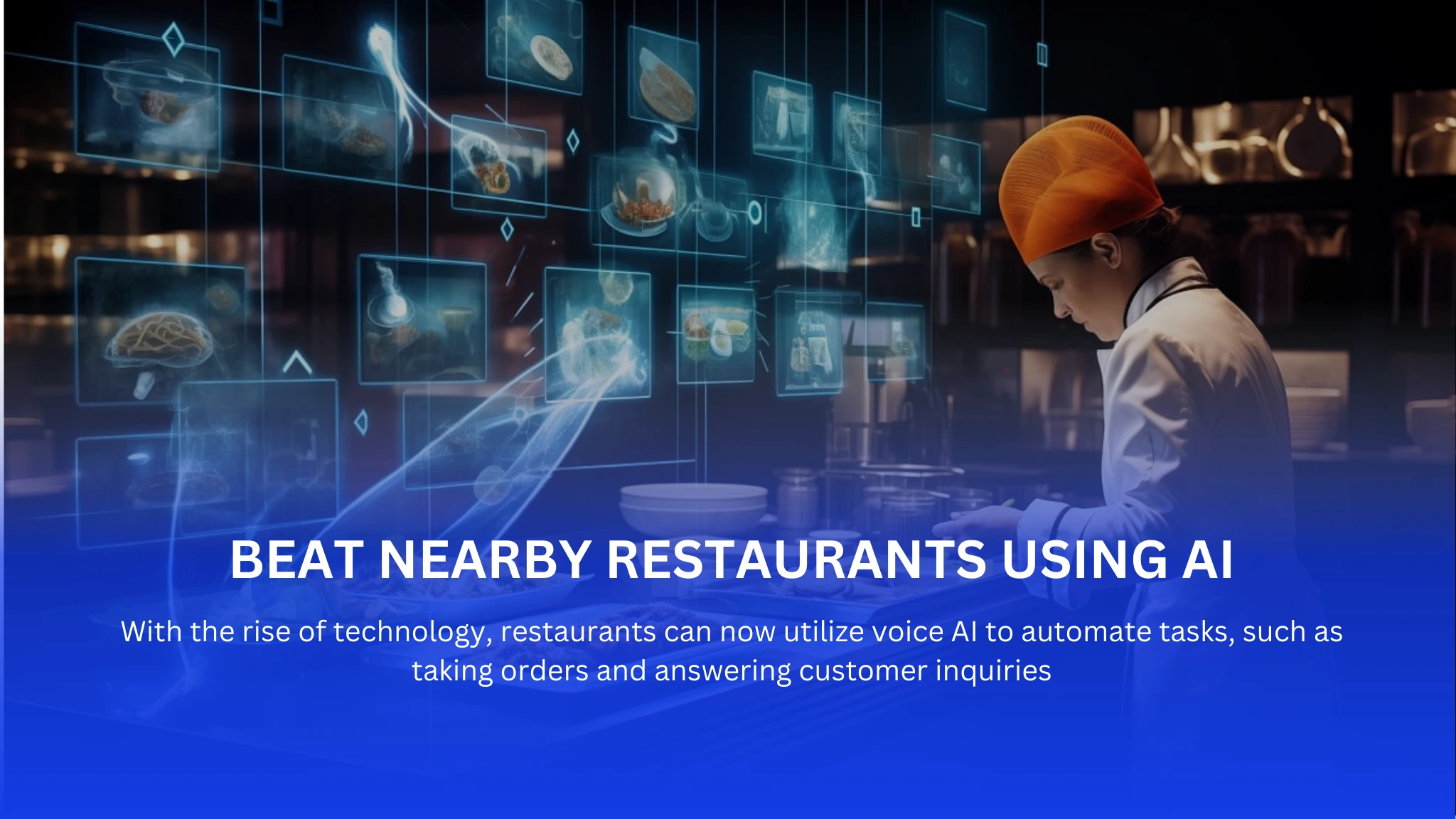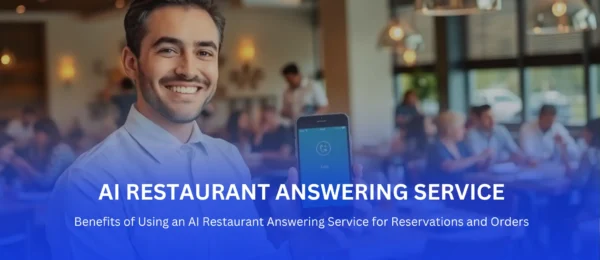VoicePlug’s conversational AI now integrated with Qu to enable intuitive voice ordering across phones and drive-thrus.Palo Alto, CA…
Learn More
How Can I Beat Nearby Restaurants and Win More Customers using AI?
Restaurants are constantly looking for ways to stay ahead of the competition and attract more customers. One effective way to achieve this is by leveraging AI-powered solutions to streamline operations and enhance customer experience.
With the rise of technology, restaurants can now utilize voice AI to automate tasks, such as taking orders and answering customer inquiries. Solutions like those offered by VoicePlug, including PizzaVOICE and other phone AI tools, not only improve efficiency but also allow staff to focus on providing exceptional service.
By implementing a phone ordering system, restaurants can reduce wait times and increase customer satisfaction. This, in turn, can lead to increased loyalty and positive word-of-mouth.
Key Takeaways
- AI-powered solutions can improve customer satisfaction and increase efficiency in restaurants.
- Voice AI can automate tasks, such as taking orders and answering customer inquiries.
- A phone ordering system can reduce wait times and increase customer satisfaction.
- Restaurants can stay ahead of the competition by leveraging AI technology.
- Implementing AI solutions can lead to increased loyalty and positive word-of-mouth.
The Competitive Landscape of Modern Restaurants
Restaurants today face a complex landscape of rising costs, increased competition, and changing consumer behaviors. This challenging environment demands that restaurant owners and managers adapt to stay ahead.
Current Challenges Facing Restaurant Owners
One of the primary challenges is the rising cost of labor, which squeezes profit margins. Additionally, the proliferation of dining options has intensified competition, making it harder for individual restaurants to stand out. Implementing efficient systems, such as a digital ordering system, can help mitigate these challenges.
The Impact of Technology on Customer Expectations
Technology has significantly altered customer expectations, with diners now expecting seamless, efficient service. The integration of phone AI solutions like those from VoicePlug can enhance the customer experience, meeting these new expectations. By adopting such technologies, restaurants can improve customer satisfaction and loyalty.
The use of technology, such as phone AI, is becoming increasingly important in the competitive restaurant landscape. By leveraging these innovations, restaurants can not only meet but exceed customer expectations, ultimately driving business success.
Voice AI for Restaurants: A Game-Changing Solution
The integration of Voice AI in restaurants is revolutionizing customer interactions and operational efficiency. This technology is not just a trend; it’s a game-changer that is transforming the way restaurants operate and interact with their customers.

What Is Voice AI Technology?
Voice AI technology refers to the use of artificial intelligence to understand and respond to voice commands. In the context of restaurants, it enables features like automated phone ordering and personalized customer interactions. Voice AI is designed to mimic human-like conversations, making it easier for customers to place orders and for restaurants to manage their operations.
How Voice AI Is Transforming the Restaurant Industry?
Voice AI is having a significant impact on the restaurant industry, particularly in two key areas: customer experience and operational efficiency.
1. Improved Customer Experience
With Voice AI, customers can enjoy a more streamlined and personalized experience. They can place orders quickly and efficiently, without having to wait on hold or navigate complex menu systems. This leads to higher customer satisfaction and increased loyalty.
2. Operational Efficiency Gains
Voice AI also helps restaurants to streamline their operations. By automating tasks like order taking, restaurants can reduce labor costs and minimize errors. Platforms such as VoicePlug are built specifically for restaurants, helping operators achieve these efficiency gains at scale. allowing restaurants to focus on what matters most – providing great food and service.
By embracing Voice AI technology, restaurants can stay ahead of the competition and provide a better experience for their customers.
The Limitations of Traditional Phone Ordering Systems
The limitations of traditional phone ordering systems are becoming increasingly apparent as technology advances. These systems, which have been the norm for many restaurants, are now recognized for their inefficiencies and potential for error.
1. Common Pain Points in Manual Order Taking
Manual order taking through traditional phone systems is prone to several common pain points. Missed calls and order errors are among the most significant issues, leading to lost revenue and customer dissatisfaction. Additionally, staff often spend a considerable amount of time answering phones, taking orders, and dealing with customer inquiries, which can be labor-intensive and costly.
2. Financial Impact of Missed Calls and Order Errors
The financial impact of missed calls and order errors can be substantial. When calls are missed, potential orders are lost, directly affecting a restaurant’s revenue. Similarly, order errors lead to rework, waste, and potentially, the loss of customer trust and loyalty.
3. Lost Revenue Calculations
Calculating the lost revenue due to missed calls involves understanding the average order value and the number of missed calls. For instance, if a restaurant misses 10 calls a day with an average order value of $25, that’s a potential loss of $250 per day, or $7,500 per month.
4. Staff Productivity Issues
Staff productivity is another area affected by traditional phone ordering systems. Employees who are busy answering phones and taking orders manually are not only more likely to make mistakes but are also not available for other tasks, such as serving customers or managing the restaurant’s operations efficiently.
By understanding these limitations, restaurants can begin to explore alternative solutions, such as AI-powered phone ordering systems, that can mitigate these issues and improve overall efficiency and customer satisfaction.
Introducing AI-Powered Phone Ordering Systems
The restaurant industry is on the cusp of a revolution with AI-powered phone ordering systems. These advanced systems are designed to streamline the ordering process, reduce errors, and enhance customer satisfaction.
Core Features of Modern Phone AI Solutions
Modern phone AI solutions come equipped with features such as automated order taking, natural language processing, and integration with existing Point of Sale (POS) systems. Automated order taking allows restaurants to handle a high volume of calls without the need for additional staff, while natural language processing ensures that orders are accurately captured.
Integration Capabilities with Existing POS Systems
AI-powered phone ordering systems can seamlessly integrate with existing POS systems, ensuring that orders are processed efficiently and accurately. This integration also enables restaurants to maintain a unified view of customer orders across all channels.
Data Collection and Customer Insights
These systems also provide valuable customer insights through data collection, helping restaurants to understand customer preferences and tailor their offerings accordingly. By leveraging this data, restaurants can improve customer satisfaction and drive loyalty.
How Phone AI Enhances the Pizza Ordering System Experience
With the integration of Phone AI, pizza ordering systems are becoming more streamlined and customer-friendly. This technology is transforming the way restaurants handle phone orders, making the process more efficient for both customers and staff.
1. Streamlining the Ordering Process
Phone AI simplifies the ordering process by automating the initial interaction, quickly capturing the customer’s order, and reducing the likelihood of errors. This streamlined process allows staff to focus on preparing orders rather than answering phones.
2. Handling Customizations and Special Requests
One of the key benefits of Phone AI is its ability to handle customizations and special requests effectively. The AI system can prompt customers for specific instructions, ensuring that their orders are accurate and tailored to their preferences.
3. Upselling Opportunities Through AI
Phone AI also provides opportunities for upselling through personalized recommendations and timing-based promotions. By analyzing customer data and order history, the AI system can suggest complementary items or promotions that are likely to interest the customer.
4. Personalized Recommendations
Personalized recommendations are made possible through advanced data analysis, allowing the AI system to suggest items that are tailored to the customer’s preferences and ordering history.
5. Timing-Based Promotions
Timing-based promotions involve offering special deals or discounts during specific times of the day or week. Phone AI can be programmed to recognize these opportunities and present them to customers at the most opportune moments.
Implementing Restaurant Phone Automation: A Step-by-Step Guide
By integrating AI-powered phone ordering systems, restaurants can significantly improve their operational efficiency. This guide will walk you through the process of implementing restaurant phone automation.

1. Assessing Your Current Phone System
The first step in implementing restaurant phone automation is to assess your current phone system. Evaluate its strengths and weaknesses, and identify areas where automation can make a significant impact. Consider factors such as call volume, order accuracy, and customer wait times.
2. Selecting the Right AI Solution Provider
Choosing the right AI solution provider is crucial for successful implementation. Look for providers that offer customizable solutions tailored to your restaurant’s specific needs. Consider their experience in the industry, customer support, and integration capabilities with your existing POS system. VoicePlug, for example, provides scalable solutions for both independent restaurants and multi-location chains.
3. Training Staff and Optimizing Workflows
Once you’ve selected an AI solution provider, it’s essential to train your staff to work effectively with the new system. This includes understanding how to handle exceptions, manage customer interactions, and monitor performance metrics.
4. Change Management Strategies
Implementing change management strategies is vital to ensure a smooth transition. Communicate clearly with your staff about the benefits and expectations of the new system, and provide ongoing support to address any concerns.
5. Performance Monitoring Tools
Utilize performance monitoring tools to track key metrics such as order accuracy, call wait times, and customer satisfaction. This data will help you identify areas for improvement and optimize your workflows accordingly.
By following these steps, you can successfully implement restaurant phone automation and enhance your digital ordering system.
Measuring ROI: The Business Case for Voice AI in Restaurants
The business case for Voice AI in restaurants is compelling, with benefits extending to cost savings, revenue growth, and enhanced customer satisfaction. By adopting AI-powered phone ordering systems, restaurants can significantly improve their operational efficiency and customer experience.
Cost Savings Through Automation
One of the primary advantages of Voice AI is the automation of phone ordering, which reduces the need for manual order taking. This not only cuts down on labor costs but also minimizes the potential for human error, leading to more accurate orders and reduced waste. Automation through Voice AI can lead to substantial cost savings, allowing restaurants to allocate resources more effectively.
Revenue Growth Opportunities
Voice AI also presents opportunities for revenue growth through upselling and cross-selling. By analyzing customer data and order history, AI systems can suggest relevant promotions and menu items, enhancing the average order value. This personalized approach to customer service not only boosts sales but also increases customer loyalty.
Customer Satisfaction Metrics
Customer satisfaction is a critical metric for restaurants, and Voice AI can significantly improve this aspect. By providing a seamless and efficient ordering experience, restaurants can enhance customer satisfaction and encourage repeat business. Metrics such as customer retention rates and satisfaction surveys can help restaurants gauge the effectiveness of their Voice AI implementation.
The business case for Voice AI in restaurants is robust, offering cost savings, revenue growth opportunities, and improved customer satisfaction. As the technology continues to evolve, its potential to transform the restaurant industry is vast.
Case Studies: Restaurants Succeeding with AI-Powered Phone Orders
AI-powered phone orders are becoming a game-changer for restaurants, enabling them to streamline their operations and improve customer satisfaction. Several establishments have already seen significant benefits from implementing this technology.
Local Pizzeria Increases Orders by 35%
A local pizzeria in New York witnessed a 35% increase in orders after adopting an AI-powered phone ordering system. The technology allowed for more efficient order taking, reducing wait times and improving customer experience.
Multi-Location Restaurant Chain Improves Efficiency
A multi-location restaurant chain implemented AI-powered phone orders across all its locations, resulting in improved operational efficiency and reduced labor costs. The chain reported a significant decrease in order errors and an increase in customer satisfaction.
Fast-Casual Restaurant Reduces Wait Times
A fast-casual restaurant in California reduced its wait times by implementing a phone AI system. The technology enabled customers to place orders quickly and efficiently, leading to increased customer loyalty and repeat business.
These case studies demonstrate the potential of AI-powered phone orders to transform the restaurant industry. By adopting this technology, restaurants can improve their efficiency, increase orders, and enhance customer satisfaction.
Overcoming Implementation Challenges and Resistance
As restaurants adopt AI-powered phone ordering, they must navigate several implementation hurdles. The successful integration of phone AI into existing systems is crucial for minimizing disruptions and maximizing benefits.
Addressing Staff Concerns
One of the primary challenges is addressing staff concerns regarding job security and the need to adapt to new technology. Effective training programs can help alleviate these concerns by highlighting how restaurant phone automation can enhance their work experience and improve customer satisfaction.
Managing Customer Expectations During Transition
Managing customer expectations is also vital during the transition period. Clear communication about the benefits of the new digital ordering system and ensuring a seamless ordering experience can help maintain customer loyalty.

Technical Integration Considerations
Technical integration is another key consideration. Ensuring that the new AI-powered system is compatible with existing POS systems and infrastructure is essential for a smooth transition. This may involve working closely with IT professionals and the solution provider to address any technical challenges that arise.
Future Trends in Smart Restaurant Ordering Technology
The restaurant industry is on the cusp of a revolution with emerging trends in smart ordering technology. As we look to the future, it’s clear that advancements in AI and related technologies will continue to transform how restaurants operate and interact with customers.
Voice Recognition Advancements
One of the most significant trends is the advancement in voice recognition technology. This technology is becoming increasingly sophisticated, allowing for more accurate and efficient ordering processes. Restaurants that adopt advanced voice AI for restaurants can expect to see improvements in customer satisfaction and operational efficiency.
Predictive Ordering and Customer Preferences
Predictive ordering is another emerging trend that leverages data and AI to anticipate customer preferences. By analyzing customer behavior and order history, restaurants can offer personalized recommendations, enhancing the dining experience and potentially increasing sales through targeted upselling.
Omnichannel Integration Possibilities
The future of smart restaurant ordering also lies in omnichannel integration. As consumers increasingly use multiple platforms to interact with businesses, restaurants must ensure a seamless experience across all channels, from online ordering to in-store pickup. AI-powered phone orders can play a crucial role in this integration, providing a cohesive and efficient ordering process.
By embracing these trends, restaurants can stay ahead of the curve, offering cutting-edge services that meet the evolving needs of their customers.
Competitive Analysis: How Your Digital Ordering System Compares
To stay ahead in the restaurant business, it’s vital to conduct a competitive analysis of your digital ordering system. This involves evaluating how your system compares to those of your competitors and identifying opportunities to improve.
Benchmarking Against Local Competitors
Benchmarking your digital ordering system against local competitors helps you understand your market position. Analyze their strengths and weaknesses to identify areas where you can differentiate your service.
Identifying Your Unique Technology Advantage
Assessing your digital ordering system’s unique features can reveal a competitive advantage. Whether it’s seamless integration with your POS system or advanced AI-powered order recommendations, highlighting these strengths can attract more customers. Phone AI technology can significantly enhance the ordering experience.
Creating a Technology Roadmap
Based on your competitive analysis, create a technology roadmap to guide future improvements. Outline key milestones, such as implementing restaurant phone automation or enhancing your online ordering platform. Regularly reviewing this roadmap will ensure you stay competitive.
Conclusion: Embracing AI to Stay Ahead in the Restaurant Industry
The restaurant industry is becoming increasingly competitive, and embracing voice AI for restaurants is crucial to stay ahead. By adopting AI-powered phone orders and restaurant phone automation, restaurants can improve customer satisfaction, increase efficiency, and drive revenue growth.
As discussed, traditional phone ordering systems have limitations, and AI-powered solutions can streamline the ordering process, handle customizations, and provide upselling opportunities. Implementing restaurant phone automation requires careful planning, but the benefits are substantial.
By leveraging voice AI for restaurants, businesses can gain a competitive edge, improve customer experience, and increase revenue. As the industry continues to evolve, it’s essential to stay ahead of the curve and adopt innovative technologies like AI-powered phone orders. Providers like VoicePlug are already enabling this transformation across small independents and large chains.
Embracing AI is no longer a choice but a necessity for restaurants to thrive in today’s competitive landscape. By doing so, restaurants can ensure long-term success and remain relevant in an ever-changing market.
FAQ
1. What is Voice AI technology, and how does it work in restaurants?
Voice AI technology is an artificial intelligence-powered solution that enables restaurants to automate phone ordering, customer service, and other tasks. It uses natural language processing to understand and respond to customer inquiries, improving the overall dining experience.
2. How can AI-powered phone ordering systems benefit my restaurant?
AI-powered phone ordering systems can help streamline the ordering process, reduce errors, and increase customer satisfaction. They can also provide valuable customer insights and integrate with existing POS systems.
3. What are the limitations of traditional phone ordering systems?
Traditional phone ordering systems can be prone to errors, missed calls, and long wait times, resulting in lost sales and decreased customer satisfaction. They also require manual order taking, which can be time-consuming and labor-intensive.
4. How can I implement restaurant phone automation, and what are the key considerations?
To implement restaurant phone automation, you should assess your current phone system, select the right AI solution provider, and train your staff. Key considerations include integration with existing systems, data collection, and customer insights.
5. What are the benefits of using Phone AI for pizza ordering systems?
Phone AI can enhance the pizza ordering system experience by streamlining the ordering process, handling customizations and special requests, and providing upselling opportunities.
6. How can Voice AI improve customer satisfaction in my restaurant?
Voice AI can improve customer satisfaction by providing a seamless and efficient ordering experience, reducing wait times, and offering personalized recommendations.
7. What are the future trends in smart restaurant ordering technology?
Future trends include voice recognition advancements, predictive ordering, and omnichannel integration possibilities, which can further enhance the customer experience and improve operational efficiency.
8. How can I measure the ROI of implementing Voice AI in my restaurant?
You can measure the ROI of Voice AI by tracking cost savings through automation, revenue growth opportunities, and customer satisfaction metrics.
9. What are the common challenges associated with implementing AI-powered phone ordering systems?
Common challenges include addressing staff concerns, managing customer expectations during transition, and technical integration considerations.
10. How can I benchmark my digital ordering system against local competitors?
You can benchmark your digital ordering system by assessing its features, functionality, and customer experience compared to local competitors, and identifying areas for improvement.
11. What are the key features to look for in an AI-powered phone ordering system?
Key features include integration with existing POS systems, data collection and customer insights, and the ability to handle customizations and special requests.
Articles you might like
An ultimate A detailed guide on the “need to have” features of the QSR POS System Falling short…
Learn MoreNovember officially kicks off the holiday rush in the U.S. — family dinners, office parties, and festive nights…
Learn MoreRunning a restaurant today means juggling constant phone calls, short staffing, rush-hour chaos, and customers who expect fast,…
Learn More




